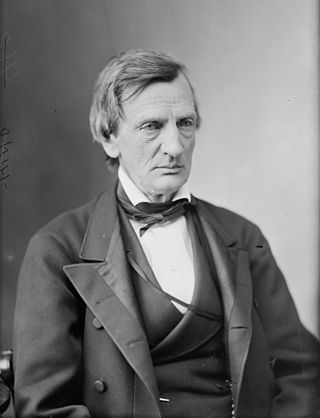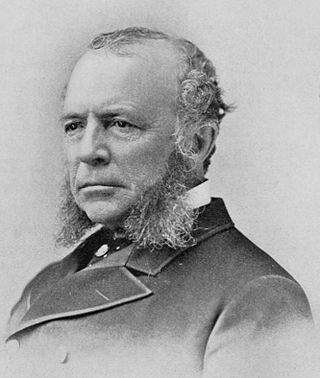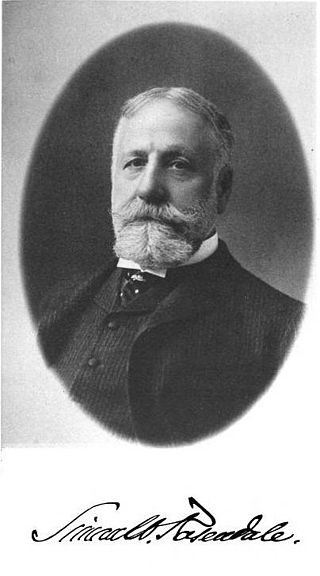Related Research Articles

William Almon Wheeler was an American politician and attorney. He served as a United States representative from New York from 1861 to 1863 and 1869 to 1877, and the 19th vice president of the United States from 1877 to 1881.

William Maxwell Evarts was an American lawyer and statesman from New York who served as U.S. Secretary of State, U.S. Attorney General and U.S. Senator from New York. He was renowned for his skills as a litigator and was involved in three of the most important causes of American political jurisprudence in his day: the impeachment of a president, the Geneva arbitration and the contests before the electoral commission to settle the presidential election of 1876.

Richard Morris Hunt was an American architect of the nineteenth century and an eminent figure in the history of architecture of the United States. He helped shape New York City with his designs for the 1902 entrance façade and Great Hall of the Metropolitan Museum of Art's Fifth Avenue building, the pedestal of the Statue of Liberty, and many Fifth Avenue mansions since destroyed.

Edwin Denison Morgan was the 21st governor of New York from 1859 to 1862 and served in the United States Senate from 1863 to 1869. He was the first and longest-serving chairman of the Republican National Committee. He was also a Union Army general during the American Civil War. Morgan was known for his progressive views on education, prison reform, and women's suffrage. He helped to found the Republican Party in New York and was a strong supporter of the Presidency of Abraham Lincoln.

Theodore Medad Pomeroy was an American businessman and politician from New York who served as the 26th speaker of the United States House of Representatives for one day, from March 3, 1869, to March 4, 1869, the shortest American speakership term. He represented New York's 24th congressional district in the United States House of Representatives from 1861 to 1869. He also served as the mayor of Auburn, New York, from 1875 to 1876, and in the New York State Senate from 1878 to 1879.

John Godfrey Saxe I was an American poet known for his re-telling of the Indian parable "The Blind Men and the Elephant", which introduced the story to a western audience.

Edward John Phelps was a lawyer and diplomat from Vermont. He is notable for his service as Envoy to Court of St. James's from 1885 to 1889. In addition, Phelps was a founder of the American Bar Association, and served as its president from 1880 to 1881.

Sanford Robinson Gifford was an American landscape painter and a leading member of the second generation of Hudson River School artists. A highly-regarded practitioner of Luminism, his work was noted for its emphasis on light and soft atmospheric effects.
John Kells Ingram was an Irish mathematician, economist and poet who started his career as a mathematician. He has been co-credited, along with John William Stubbs, with introducing the geometric concept of inversion in a circle.
Charles Yates was a Brigadier-General during the American Civil War in command of the volunteer depot of New York City in 1861.
John Saxe may refer to:

The 1876 New York state election was held on November 7, 1876, to elect the governor, the lieutenant governor, a judge of the New York Court of Appeals, a Canal Commissioner and an Inspector of State Prisons, as well as all members of the New York State Assembly and two members of the New York State Senate. Besides, two constitutional amendments were proposed - to abolish the elected Canal Commissioners and appoint a Superintendent of Public Works instead; and to abolish the elected New York State Prison Inspectors and appoint a Superintendent of State Prisons instead - and both were accepted by the electorate.

Simon Wolfe Rosendale was an American lawyer and politician. Rosendale was the first Jew elected to a statewide elective office in New York.

John Godfrey Saxe II of Manhattan was a lawyer and a member of the New York State Senate. He was a delegate to the New York State Constitutional Convention representing New York's 16th congressional district in 1915. He was president of the New York State Bar Association, and counsel for Columbia University.
Theodore Augustus Havemeyer was an American businessman who was the first president of the U.S. Golf Association and co-founder of the Newport Country Club, host to both the first U.S. Amateur and the first U.S. Open in 1895.
Saxe is a surname. Notable people with the surname include:

William Orton was an American businessman who served as president of the Western Union Telegraph Company.

Robert Shaw Oliver was an American soldier and businessman.
Isaac Samuel Johnson was an American lawyer and politician from New York.
References
- ↑ "Marriage Announcement". Chicago Tribune . January 22, 1876. Archived from the original on November 4, 2012. Retrieved 2010-09-23.
- ↑ "John G. Saxe Dead, 75. General Counsel for Columbia. Headed State Bar. Expert on Election Statutes". New York Times . April 18, 1953. Retrieved 2010-09-22.
- ↑ Cuyler Reynolds (1914). "John Theodore Saxe". Genealogical and family history of southern New York. pp. 1097–1101. Retrieved 2010-09-22.
- ↑ "A Man of Many Sorrows". Chicago Tribune . July 7, 1881. Archived from the original on July 18, 2012. Retrieved 2010-09-23.
Mr. John Theodore Saxe, son of John G. Saxe, was buried yesterday afternoon. Only relatives and the nearest friends were invited to the funeral. The almost unprecedented family misfortunes of the genial poet have excited universal attention. They began in 1874, when Mr. Saxe was a resident of Brooklyn.